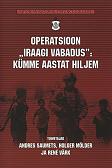IRAANI IDEOLOOGIAST JA GEOPOLIITIKAST LÄBI AJALOO NING SELLE MÕJU IRAAGILE
THE IDEOLOGY AND GEOPOLITICS OF IRAN TROUGH HISTORY AND ITS INFLUENCE ON IRAQ
Author(s): René Värk, Holger Mölder, Vladimir SazonovSubject(s): Politics / Political Sciences
Published by: Kaitseväe Ühendatud Õppeasutused
Keywords: history of Iran; ideology; state politics; Iran-Iraq War; theocracy; islamic revolution
Summary/Abstract: Throughout its history, from its glorious past to the present, Iran has had a tremendous impact on its neighbouring Iraqi areas. Iran is a regional power, which possesses a good economy, strong armed forces and an emergent nuclear capability. Nevertheless, Iran is governed according to theocratic rule structures and is led by a conservative Shia clergy that follows Islamic law. This has led the country into international isolation. Lately, after the moderate clergyman Hassan Rouhani was elected as a president (2013), Iran has made efforts to re-join the international community. There are basically two general areas which factor into Iran’s position in the international community: their potential to develop a nuclear capability into nuclear weapons and their support of the regime of Assad in Syria. It is diffi cult to prognosticate changes in Iran’s society. Iran is a very ancient country with more than 4500 years of history but with no experience of democracy. For all these centuries Iran has been ruled by autocratic monarchies followed by a theocratic dictatorship for the last 35 years. Shia Islamism, combined with the historical heritage of previous powerful royal dynasties such as the Achaemenides, the Sassanides and the Safavides as well as others, have influenced Iran’s ideology up to present times. However, if we examine Iranian geopolitics from a historical perspective, we have to keep in mind that Iran has historically been one of the largest, most powerful and enduring countries in the Middle East, and its culture, politics and ideology have always had a major impact on its neighbours. The Iranian influence on Iraq is obvious, considering that the majority of the Iraqi population is Shiite Muslims, who are mainly concentrated in the southern region of the country. The Shia holy cities Karbala and Najaf are also located in Iraq. After the international military intervention in Iraq in 2003, which made possible the participation of the Iraqi Shia majority in power sharing and allowed them to dominate the Parliament, the influence of Iran on neighbouring Iraq has only increased. If before the bilateral relationship was characterized by many difficulties and clashes, which led to Iraq-Iran war in 1980–1988, then at present the prospects for future cooperation look promising.
Journal: KVÜÕA toimetised
- Issue Year: 2014
- Issue No: 18
- Page Range: 197-242
- Page Count: 46
- Language: Estonian

